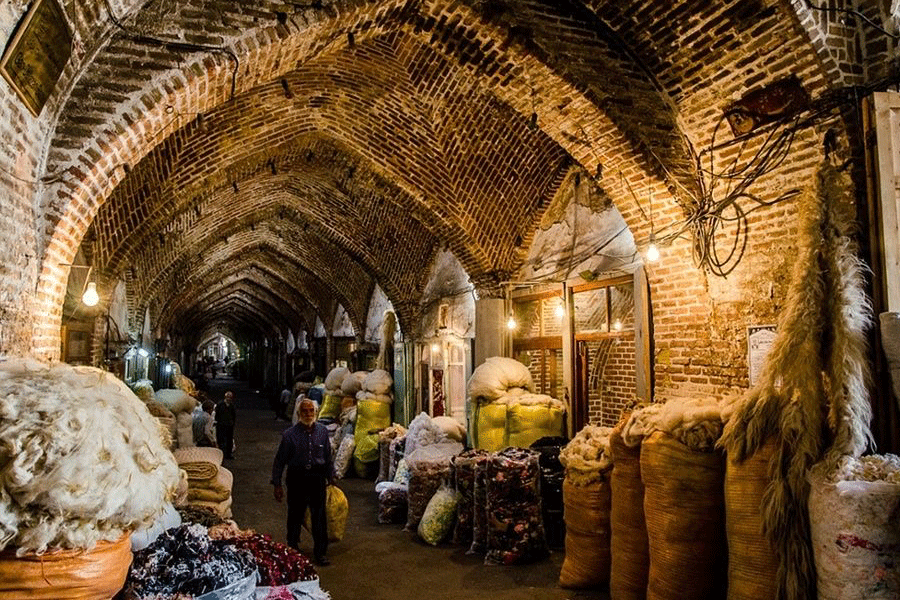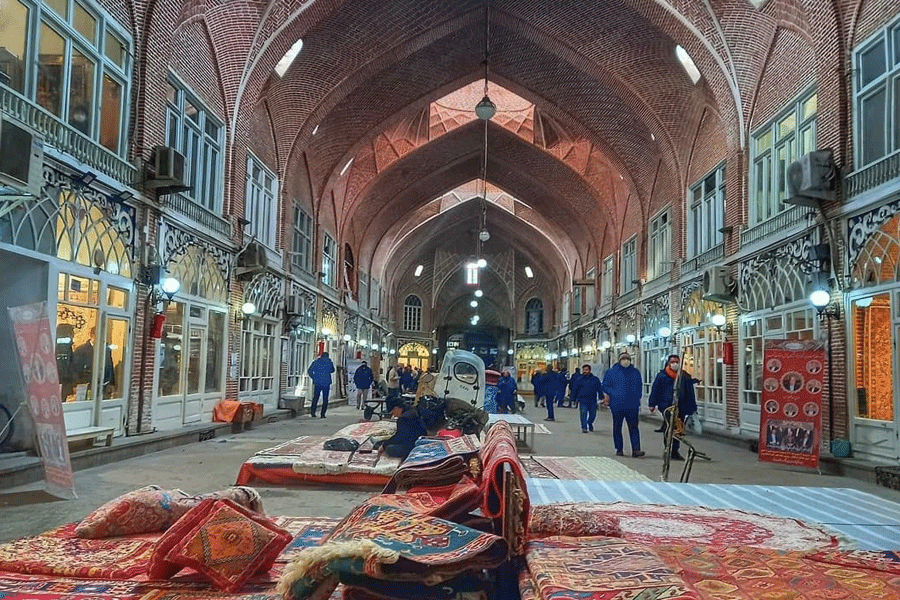
Exploring the Grand Bazaar of Tabriz
Nestled in the northwest of Iran, Tabriz stands as one of the country’s key tourism hubs, rich with historical and cultural heritage. Known for its strategic geographical location, Tabriz offers a blend of natural and historical attractions. In 2018, it was recognized as a model city for tourism in the Islamic world. Throughout the year, Tabriz attracts numerous domestic and international visitors. Let’s delve into the enchanting Tabriz Grand Bazaar, one of the many gems of this magnificent city.
Features of the Tabriz Bazaar
The Tabriz Bazaar, covering over one square kilometer, is the largest interconnected brick complex in the world. It boasts 5,500 shops, 20 rows, 25 timchehs (small arcaded courtyards), and 35 houses, along with schools, baths, mosques, and caravanserais.
Together, these sections make the Tabriz Bazaar a standout among Iranian traditional bazaars. Recognized as one of Tabriz’s key attractions, it was added to the list of Iran’s National Heritage sites in 1975. In 2010, the bazaar gained further acclaim when it was registered as part of the Silk Road and recognized as the largest roofed structure in the world by UNESCO World Heritage Sites in Iran.
The Tabriz market functions as a vital center for collection, distribution, and retail. It offers an array of goods, including hand-woven carpets, leather bags, shoes, herbal and medicinal products, spices, and fabrics. Despite its traditional ambiance, the market also accommodates modern items like mobile phones and computers, blending the old with the new.
The presence of the Jame Mosque and schools like Sadeghieh within the Tabriz Bazaar highlights its cultural and religious significance. During Nowruz, Ramadan, and Muharram mourning days, the market’s economic activities take a backseat. In particular, with the arrival of Muharram, the bazaar is adorned in black, and most shops close from the 8th to the 12th of the month, reflecting the deep reverence for these religious observances.
Timcheh Mozafaria, as the main center of mourning, hosts the largest number of mourning groups during religious observances. Alongside the mourning, bazaar patrons distribute offerings such as tea, dates, and cookies to the Hosseini mourners. The mourning rituals at the Tabriz Bazaar hold significant cultural importance and are registered as national rituals.
The Tabriz market stands out as a key tourist attraction in East Azarbaijan province and as a unique example of a bazaar in Iran’s colder regions. Sadly, it has suffered from neglect in recent years. The market’s infrastructure has deteriorated, and it lacks modern, high-quality equipment. This ongoing decline threatens the bazaar’s social and economic vitality, a situation that will worsen if it continues to be overlooked by authorities.
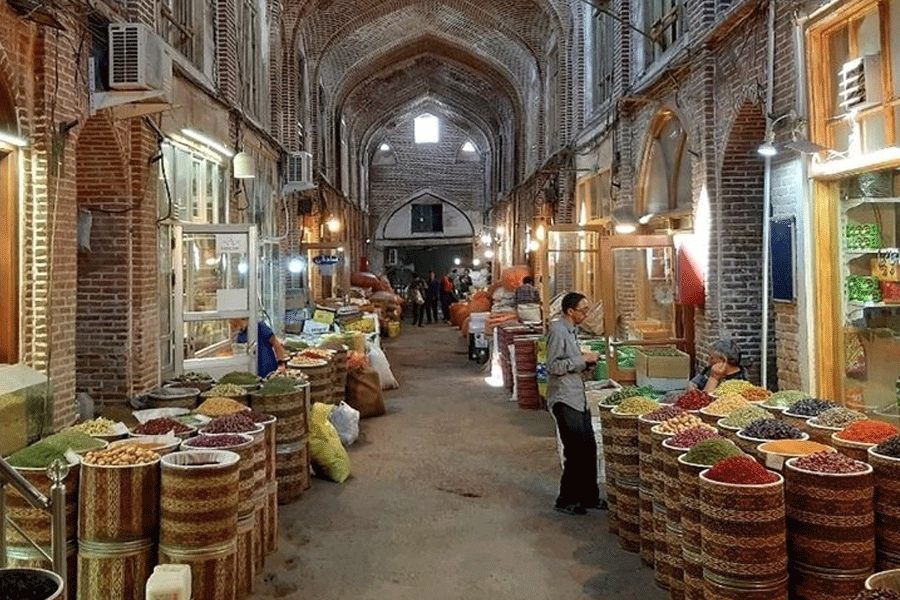
Location of Tabriz Bazaar
The Tabriz Bazaar is strategically situated, with the Jame Mosque to its west and Ali Qapu to its east, while parts of the Maidan Chayi River lie to the north. A significant portion of the bazaar is located south of Chay Square, spanning the area between Shohada, Darayee, Chaykenar, Ferdowsi, Shahid Motahari, and Jomhuri Eslami streets.
History of Tabriz Bazaar
The exact origins of the Tabriz Bazaar are not well-documented, but it has been a significant site for centuries. From the 4th century AH to the Qajar era, renowned travelers such as Ibn Battuta, Marco Polo, Yaqut Hamavi, Gaspard Droville, Jean Chardin, Jamli Cardi, and Hamdullah Mostofi visited the bazaar. These travelers not only praised its grandeur but also documented their experiences in their writings and books.
Located along the Silk Road, Tabriz was a major hub for caravans traveling from various parts of the world. During its peak, the Tabriz Bazaar thrived as one of the most crucial trading centers of its time. Its significance was such that the bazaar’s gates were regarded as the main entrances to the city.
Paintings from the Seljuk era depict a bazaar at the current site of the Tabriz Grand Bazaar, which gained considerable fame during the Ilkhanid period. The bazaar’s prosperity continued when Tabriz became the capital, extending into the Safavid era. Its prominence was such that traders from various cities flocked to this bustling market.
Throughout its long history, the Tabriz Grand Bazaar has weathered numerous events, including destructive earthquakes such as the one in 1193 AH. Despite these challenges, the bazaar has been continuously renovated and restored. The current structure of the Tabriz Bazaar largely dates back to the late Zandiyeh and Qajar periods.
During the Qajar Era
In the Qajar era, Tabriz, situated close to European markets and serving as the Crown Prince’s city, continued to thrive. The bazaar maintained its prosperity and significance, serving as a key hub for Iran’s exports to Europe.
During the 13th century, under the patronage of Abbas Mirza, the Qajar crown prince, the Tabriz Bazaar rose to prominence as a renowned commercial center. English traders, traveling via the Silk Road, frequently visited the market, further cementing its importance as a key trading hub.
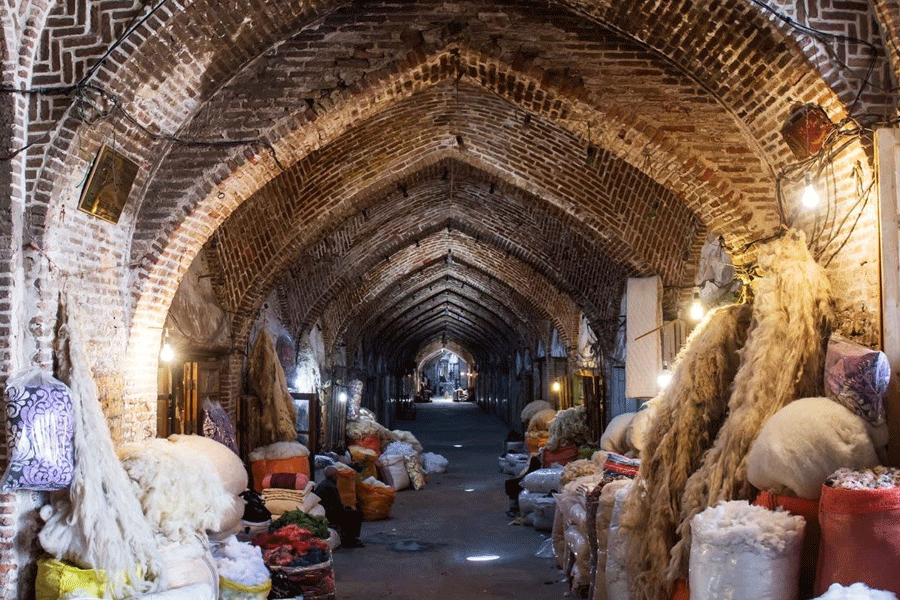
During this period, the volume of transactions at the Tabriz Bazaar was so significant that approximately 30% of Iran’s business dealings were conducted there. Under Abbas Mirza’s reign, the area saw extensive development, including the construction of his palace complex, Ali Qapu, to the east of the bazaar, along with numerous other palaces and timchehs.
Additionally, historical landmarks such as the Jame Mosque, Sadeghieh School, and Haj Safar Ali School further attest to the rich historical background of the Tabriz Bazaar complex.
The Tabriz Bazaar was a vibrant hub for both imports and exports during this period. European goods such as mirrors, various fabrics, glass, sugar, and metal were imported into Iran. In exchange, the bazaar offered a range of Iranian products for European buyers, including silk, tobacco, dried fruits, shawls, oak apple, and wax.
Tabriz Bazaar Architecture
The architecture of the Tabriz Bazaar is designed to blend seamlessly with the urban fabric, giving its outer appearance a resemblance to typical buildings. Its significance extends beyond its size; it showcases the architectural mastery of using bricks and brick pottery, resulting in a variety of distinct and intricate spaces.
A distinctive feature of the Tabriz Bazaar is the vents embedded in the centers of its arches, designed to allow hot air to escape efficiently. Additionally, in certain areas of the market, valves are intentionally absent to prevent unwanted wind flows. The bazaar’s thick walls also play a crucial role in retaining heat during the winter months.
Given Tabriz’s rainy and cold weather, the market rows are covered to provide protection. The roofs of the bazaar reach a height of 5 to 6 meters, which is lower compared to markets in Iran’s warmer regions, helping to retain heat. As you walk through the market, you’ll notice that the rows are approximately four to five meters wide and oriented in a north-south direction.
Important Sights of Tabriz Bazaar
While exploring the grand Tabriz Bazaar, be sure to visit these notable sights:
Timcheh Mozafariyeh: A prominent historical caravanserai.
Amir Serai: A significant architectural and historical site.
Tabriz Jame Mosque: An important religious and historical landmark.
Talebiyeh School: A notable educational institution.
Khan Hamam: A historic bathhouse.
Imamzadeh Jamal: A revered shrine.
Tabriz Bazaar Museums: Offering insights into the bazaar’s rich history.
Zoorkhaneh Garshasb-e Yal: A traditional Persian sports venue.
Haj Ali Restaurant: A place to enjoy local cuisine.
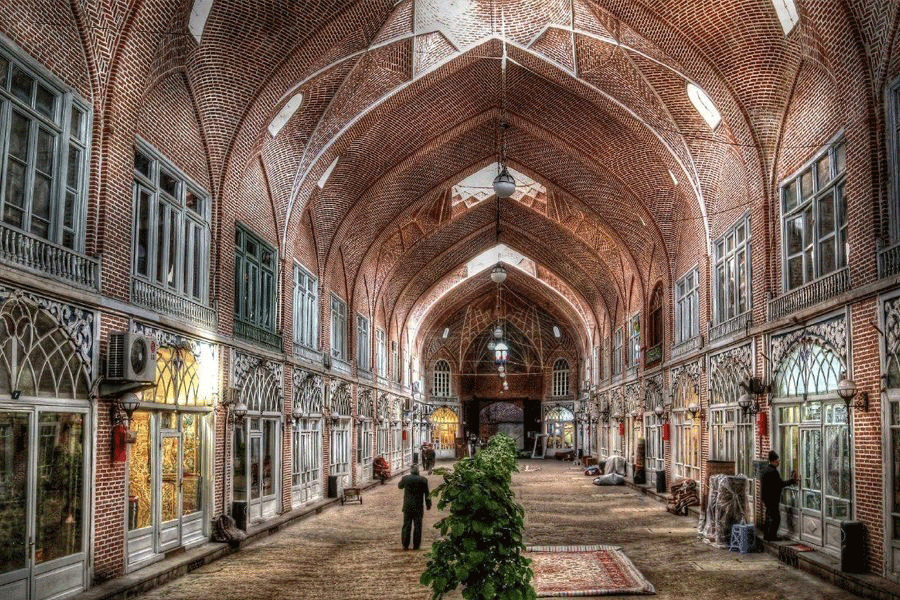
Is It the Largest Covered Bazaar in the World?
Many sources and websites highlight the Tabriz Bazaar as the world’s largest covered market, a feature that sets it apart and makes it particularly distinctive. However, it’s also worth noting that the Grand Bazaar in Istanbul is often recognized in some sources as the oldest and largest indoor market in the world. This can lead to some confusion, as both markets are renowned for their historical and architectural significance.
A review of the English Wikipedia pages for both markets reveals that the Grand Bazaar in Istanbul is recognized as one of the largest and oldest covered markets in the world, while the Tabriz Bazaar is noted as the largest covered market globally. Additionally, articles from the reputable Guardian newspaper refer to the Tabriz Bazaar as the world’s largest roofed bazaar, whereas the Grand Bazaar in Istanbul is described as one of the largest covered bazaars.
Where to Eat Near the Tabriz Bazaar
Here are some of the best dining options around the Tabriz Bazaar:
- Urban Cafe: Valman Street
- Baliq Restaurant: Nowbar Street
- Tabriz Modern Restaurant: Near Shariati Square, Emam Kh Street
- Berkeh Restaurant: Ring Road of Sardroud
- Haj Ali CheloKababi: Inside the Tabriz Bazaar
- Delestan Restaurant and Fast Food: In front of JamJam, 29 Bahman Street
- Shazdeh Restaurant: No. 111, Entrance of Small Dallaleh Zan, Sadegheh Bazaar
- Barcode Restaurant and Cafe: Ghanun Street, Inside Jazireh Complex
- Unlu Wine and Dine: Tabriz Khalil Rza, 40
- Good Fish: North Shahriar, Valiasr
Where to Stay Near the Tabriz Bazaar
Here are some hotels you can consider near the Tabriz Bazaar:
- Tabriz International Hotel: Emam Street, University Circle, Tabriz, Iran
- Gostaresh Hotel: Abresan Avenue, Tabriz 12454, Iran
- Morvarid Hotel: Bagh Golestan Square, Tabriz, Iran
- Hotel Behbood Tabriz: No. 9, just past the North Garden Crossroads, Shoaar Alley, Tabriz, Iran
- Shahryar International Hotel Tabriz: El Goli Street, Shahid Bakeri Boulevard, Tabriz, Iran
- Tabriz El-Goli Pars Hotel: El Goli Street, Tabriz, Iran
- Laleh Park Hotel: Pasdaran Runway, Shahid Fahmideh Square, Tabriz 360025, Iran
- Darya Hotel: 22 Bahman Avenue, Tabriz, Iran
How to Get to the Tabriz Bazaar
Address: Tabriz Grand Bazaar, East Azarbaijan Province, Tabriz, Iran
The Tabriz Bazaar is accessible from various parts of the city. You can enter the bazaar from Rasteh Kocheh, Jomhuri, and Darayee Streets.

